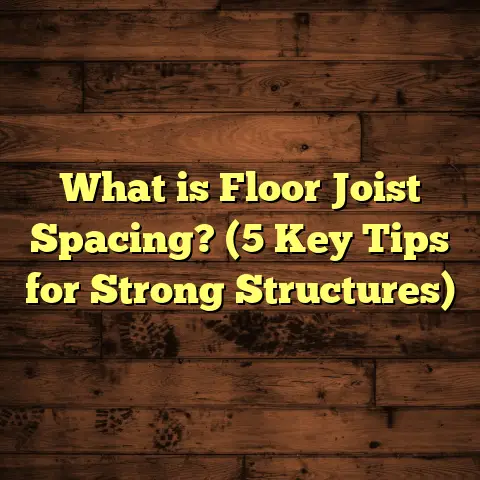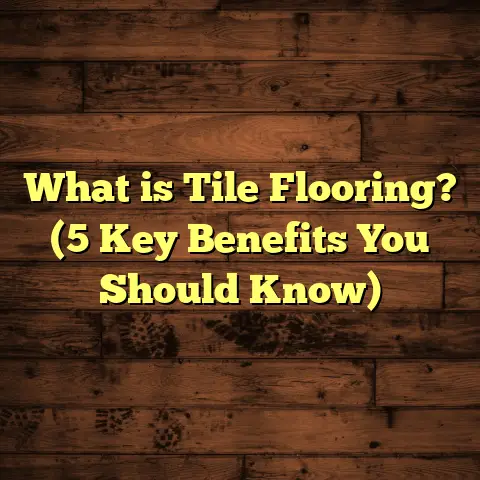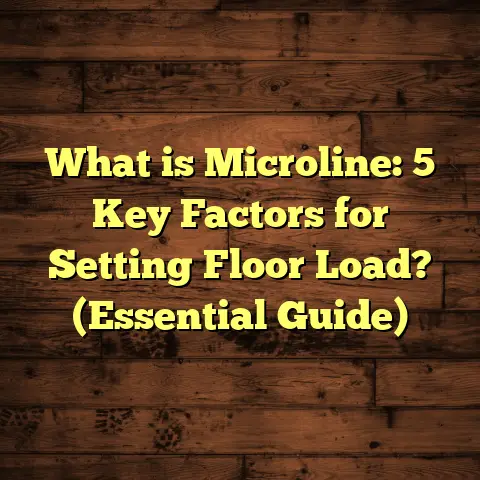What is Spongy Feeling Floors? (5 Signs You’re at Risk!)
I remember the first time I encountered a floor that felt… well, spongy. I was visiting a friend’s newly renovated house, excited to see the work they had done. But when I stepped into the living room, something felt off. The surface beneath my feet wasn’t firm like I expected—it had this soft, bouncy give, almost like walking on a thick sponge. At first, I thought it was just me or maybe a trick of the light, but as I walked around, the sensation didn’t go away. That moment stuck with me because it was my first real “aha” experience with what a spongy feeling floor actually means—and why it can be a sign of trouble.
Since then, I’ve come across many floors with the same problem and learned a lot about what causes this odd sensation, how to spot it early, and what to do about it. If you’re here wondering “What exactly is a spongy floor? Is my floor at risk? And how can I fix or prevent this?”—let’s get into it.
What Is a Spongy Feeling Floor?
Simply put: a spongy feeling floor is when your floor doesn’t feel solid and stable underfoot. Instead of being firm, it feels soft or bouncy—like stepping on a cushion or sponge rather than wood, tile, or concrete.
This softness usually points to an issue underneath the visible flooring layer. Your floor isn’t just the top surface you walk on; it has several layers below that work together to provide support and durability. When one of these layers loses strength—often the subfloor or joists—the floor can start to feel soft and unstable.
Breaking Down the Layers
To understand why a floor might become spongy, you have to know the layers involved:
- Finish Layer: This is what you see and walk on—hardwood planks, tiles, vinyl sheets, carpet, etc.
- Underlayment: A thin layer between the finish and subfloor that helps with soundproofing, moisture control, or leveling.
- Subfloor: Usually plywood or oriented strand board (OSB), this layer provides structural support.
- Joists: The beams underneath the subfloor that hold up the entire floor system.
When any of these layers weaken or fail, your floor can lose its firmness.
Why Does Sponginess Occur?
From my years working in homes and talking with other contractors, I’ve found that spongy floors usually happen due to one or more of these reasons:
- Water Damage: Moisture is the number one enemy of subfloors and joists made from wood. Leaks from plumbing or roofs, flooding, or even high humidity can cause wood to rot and lose strength.
- Poor Installation: If the subfloor isn’t properly fastened or if unsuitable materials are used, the floor won’t have the support it needs.
- Structural Shifts: Over time, houses settle and move slightly. Joists can warp or shift out of alignment.
- Material Degradation: Some materials naturally degrade faster than others under stress or exposure to moisture.
- Lack of Maintenance: Ignoring small issues like squeaks or minor soft spots lets problems grow into larger ones.
This understanding is key because it means that spongy floors aren’t just an annoying sensation—they’re warning signs of underlying damage that could worsen if left unchecked.
How Did I Start Noticing Spongy Floors?
When I started working on home renovations years ago, soft floors were something I didn’t pay much attention to at first. I focused mostly on surface repairs—refinishing hardwood, fixing loose tiles, installing new carpet. But then I noticed clients coming back with complaints that their new floors felt “off.” Curious, I began lifting sections of flooring to check what was underneath.
What I found surprised me: water damage hidden beneath laminate planks in basements, sagging plywood subfloors in kitchens where plumbing leaks had gone unnoticed for months, joists weakened by age and moisture. These hidden issues were causing soft spots and even structural risks.
One case stands out: A couple had just installed brand-new hardwood floors in their living room. After a few weeks, their kids complained the floor felt “bouncy” near the windows. Upon inspection, I found a leak from a nearby window frame had soaked the subfloor and caused wood rot. The fix was extensive and costly—not because the hardwood itself was bad but because the base beneath it was compromised.
That’s when I realized how important it is to detect sponginess early and understand what causes it.
5 Signs You’re at Risk for Spongy Floors
If you want to avoid unexpected repair bills or safety hazards later on, look out for these signs:
1. Soft or Bouncy Spots When You Walk
This is often the most obvious sign. When you step on certain areas of your floor and feel them give way slightly or bounce back like a spring, it means something below isn’t firm.
I always advise homeowners to walk around barefoot and pay attention to any spots where the floor doesn’t feel uniformly solid. This can indicate water-damaged subfloor or loose boards not properly secured.
2. Creaking or Popping Sounds
Floors naturally make noise as they expand and contract with temperature changes. But if you hear persistent creaking or popping sounds every time you walk in certain places, that often means movement in the joists or subfloor.
I remember a client who thought their floor was just “old and noisy.” When I inspected it, I found several nails had popped out from underneath because the subfloor was flexing too much due to moisture damage.
3. Visible Sagging or Unevenness
Take a look around your home — do you notice any dips or uneven patches on your floor? Even small areas where the floor looks like it’s sagging can be early warning signs that the support below has weakened.
Using a level tool can help identify these uneven spots too. Sagging floors usually mean joists or subfloor have lost strength.
4. Gaps Between Floorboards
Floorboards naturally expand and contract with changes in humidity but large gaps appearing between boards may signal moisture issues affecting the wood’s integrity.
If those gaps feel loose underfoot or you can push down in the spaces easily, that softness usually follows shortly after.
5. Moisture Smell or Visible Water Damage
One of the clearest signs of trouble is detecting moisture — either through musty odors near floors or visible stains and discoloration on surfaces.
I once worked on a home where the owners ignored a slight waterYour request failed. Please try again.





